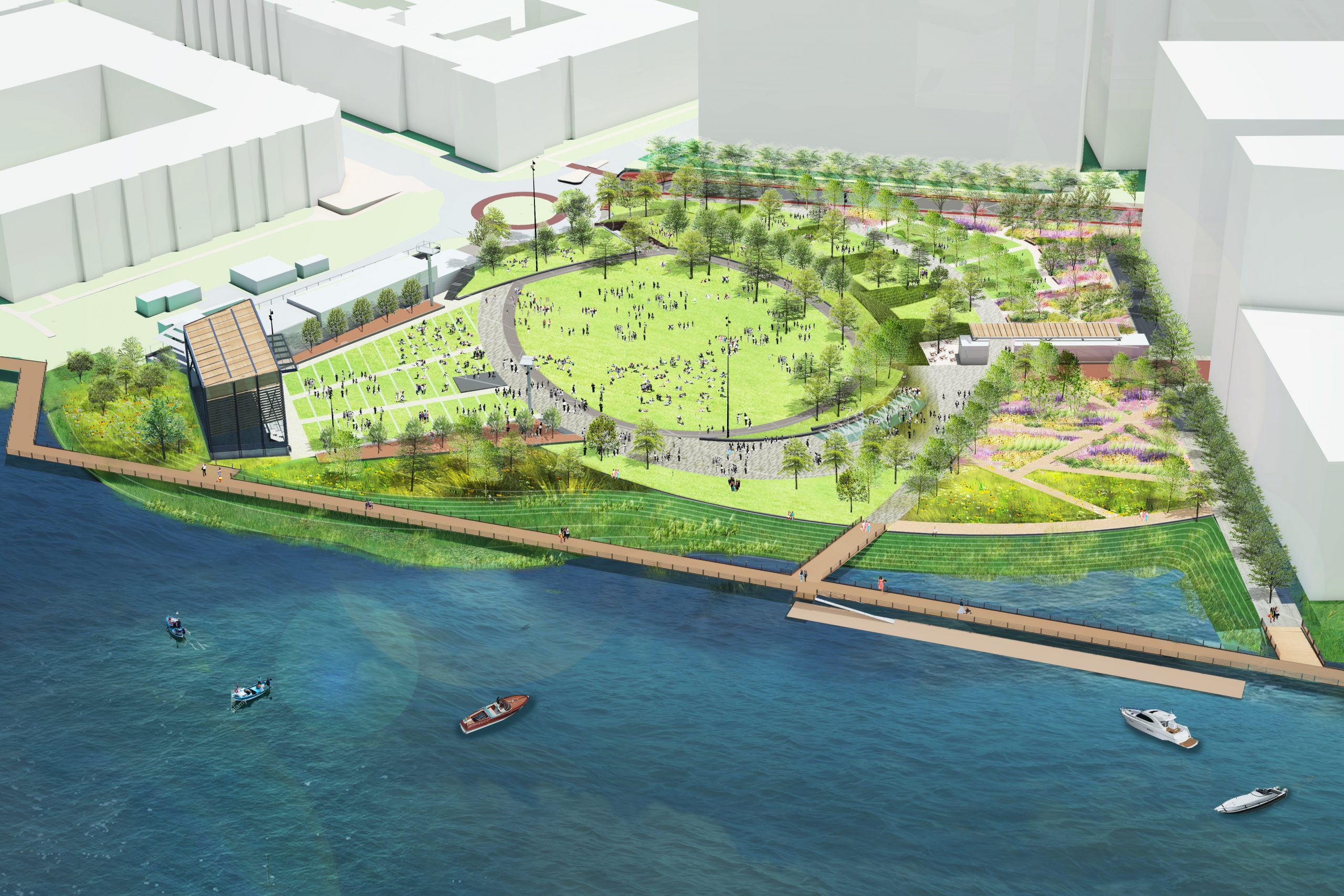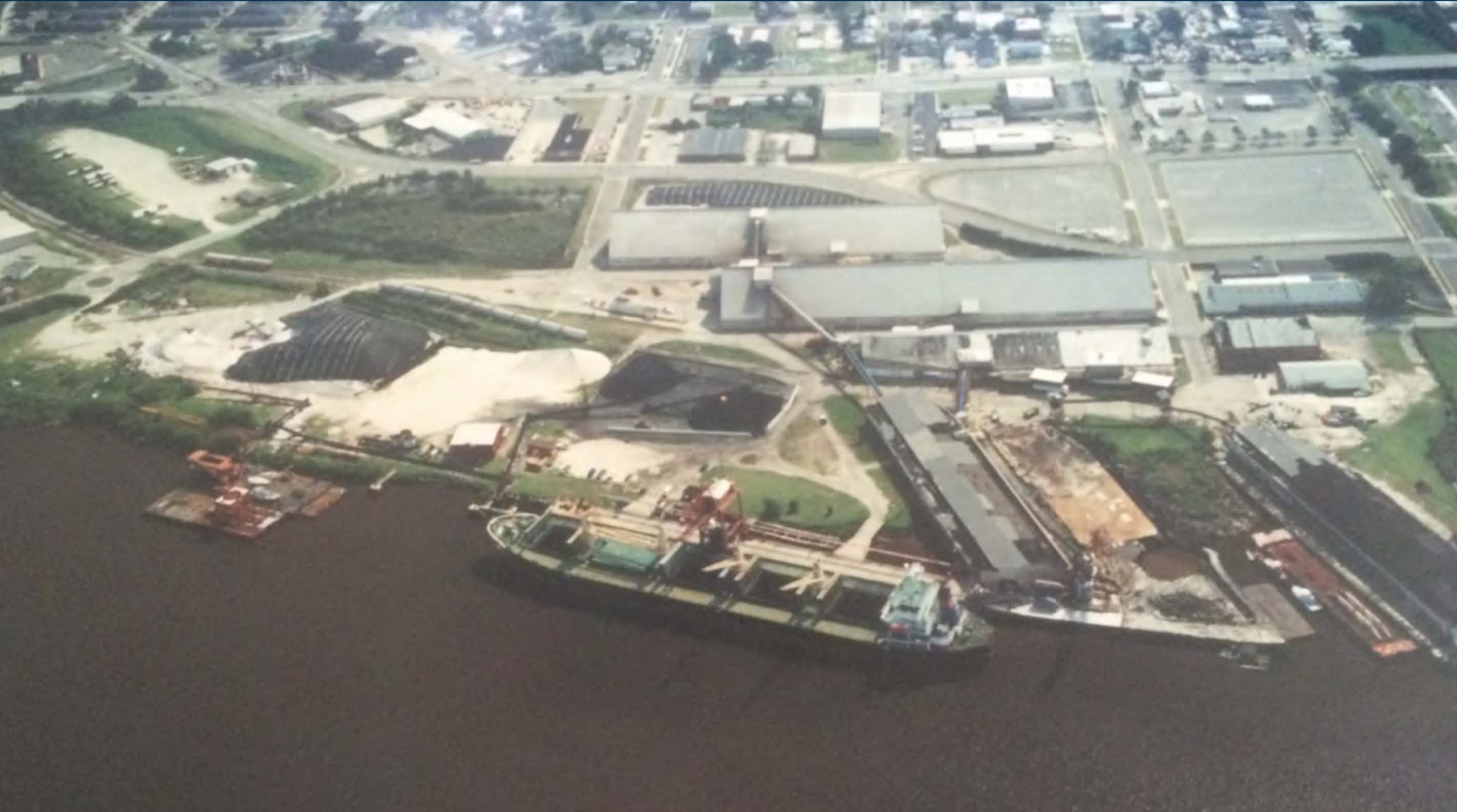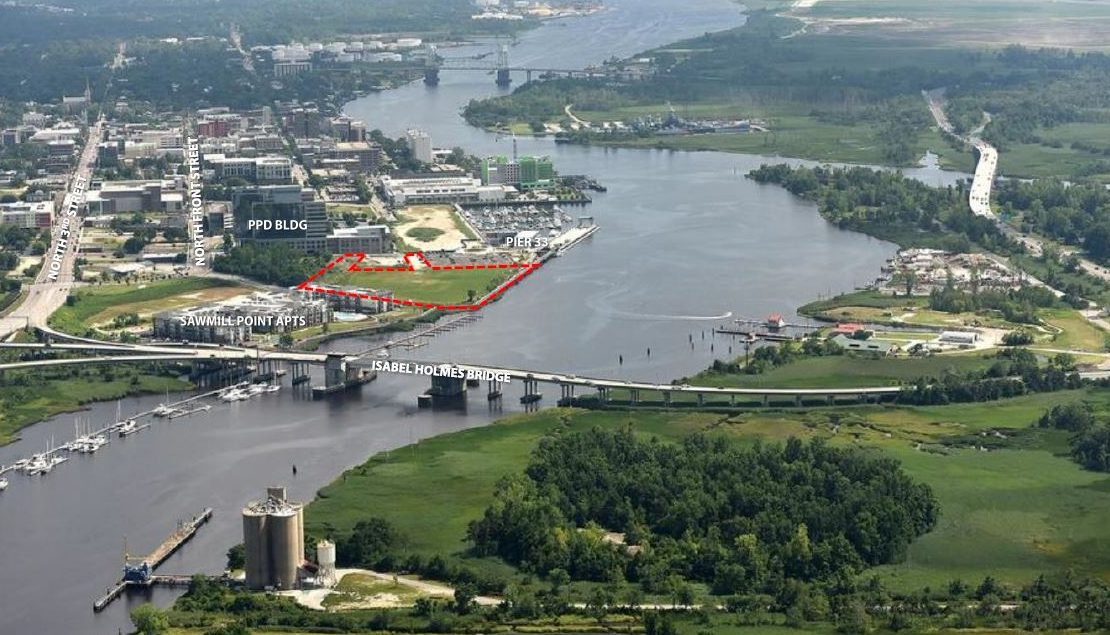
The idea for a waterfront park in downtown Wilmington on a former industrial site came about a decade ago.
After years of planning, officials say work on the nearly 7-acre North Waterfront Park is on pace for completion by June 2021.
Supporter Spotlight
The North Waterfront Park, billed as Wilmington’s signature urban park, is the only public area downtown where a person can interact more closely with the river, without a seawall or boardwalk separating the park user from the river, Amy Beatty, Wilmington’s community services director, told Coastal Review Online.
The site on the northeast Cape Fear River between Cowan and Nutt streets is in a mixed-use district and has a newly-constructed section of the Riverwalk, a pump station and several sites available for high-density urban development.
The park will include a large concert venue and festival space, greenspace, lawns, shade trees, a playground and splash pad, a large plaza, trails, a riverwalk, gardens and natural areas.
“Staying on the theme of water, the park will feature a large-scale water feature that will serve as both an art piece and a place where kids can cool off in the summer,” she explained.
The landscape will feature outdoor “rooms,” or grassed areas separated by vegetative berms that back up to the performance venue lawn, where exercise classes and other group activities can take place. “There will be a children’s play area next to manicured gardens and a more natural coastal garden with paths, closer to the river,” Beatty said.
Supporter Spotlight
New York-based Hargreaves Jones headed up the design and engineering team for the project and worked with the city, promoter and venue operator Live Nation and Clancy & Theys Construction Co. to design the waterfront park and event venue on the historic brownfield site, property that has been abandoned or underused because of environmental contamination or concern it exists on the site.
Almont Shipping Facility was located on the site from about 1850 to 2005. During that time, the site has been documented to be used for storage and distribution of potash, zircon sand, granite, limestone, canola meal, calcium nitrate, ammonium nitrate, iron ore pellets, pelletized urea, chromium ore, salt and salt cake. A portion of the Almont Shipping Facility also included the bulk storage of petroleum products, according to the city.
Riverfront Holdings II, LLC. entered into a Brownsfield Agreement in 2008 with the state for a 23.37 acre site, which includes the North Waterfront Park site. As a condition of the city’s offer to buy the park, the property was capped with 2 vertical feet of clean fill.

The park plan was recognized earlier this month by the Waterfront Alliance of New York for “reaching the highest standard in resilient waterfront design in the country.” The plan has been verified through the alliance’s Waterfront Edge Design Guidelines, or WEDG, program, a rating system and guidelines for resilient, ecological and accessible waterfronts. The Wilmington park is the 10th WEDG-verified project and the first outside of the New York City region.
For those interested in learning more about the park and the WEDG verification, a virtual, interactive discussion and presentation from the design team is set for noon Monday. Register online to participate.
WEDG Senior Program Manager Sarah Dougherty explained in an interview that WEDG is similar to the LEED rating system for green buildings and communities.
“We help create better outcomes for waterfront projects through project review, professional education, and community engagement,” she said.
Beatty, Wilmington’s community services director, said that the momentum for the park began in 2009 when the city entered into a development agreement for the northern downtown district with Riverfront Holdings. At the time, Wilmington was to receive about a half-acre for a park at Harnett and Nutt streets valued at $436,000, but the agreement was later amended and the city negotiated for a larger park.
“On Nov. 19, 2013, the Wilmington City Council voted unanimously to purchase 6.63 acres of property now known as North Waterfront Park. The $4.1 million park was purchased through a combination of general fund dollars and capital project balances,” Beatty said. “The urban park fulfilled a long-held goal to provide sizable open space for residents, employees and visitors to downtown Wilmington, a goal identified in the City’s Parks, Recreation and Open Space Master Plan and in Vision 2020, A Waterfront Downtown plan.”
To begin the park’s master plan process, the city established common objectives, with the primary goal of “delivering a safe, clean, comfortable park for citizens and visitors, maximizing opportunities to engage with the Cape Fear River, providing a versatile performance space and making sure the park is accessible to all,” Beatty said.
“And, of course, providing much-needed lawns, gardens and trees,” she added.
She said Wilmington’s existing Riverfront Park is a great meeting space and a perfect spot for river views, but it has limitations, especially for landscaping. During the planning process, time was invested in researching successful urban parks.
“We took a year to develop the master plan and more than six months on the community engagement process. We wanted this park to be the result of what our citizens told us was important to them. We put a great deal of thought into how this park will serve Wilmington’s families, downtown residents and workers, retirees, visitors and tourists,” she said. “‘Vibrant’ is the word I keep coming back to. Essentially, to me that means the park should be clean, safe, enjoyable and beautiful no matter what day of the week it is, time of day or whether you are there for a programmed event or for a casual visit.”
The construction contract of $29.17 million for the final plan, which underwent several revisions and a re-bid to reduce construction expenses, was approved in November 2019. The park was initially estimated to cost around $20 million, per the city’s website. The increase in cost was tied to infrastructure, improvements in and around the site, and construction cost inflation that has become more pronounced since Hurricane Florence in 2018. The park will be partially funded by the voter-approved 2016 Parks Bond.

A major component of the park is the performance venue that will be managed by California-based Live Nation. The partnership with Live Nation evolved through Beatty’s work managing the Hugh Morton Amphitheater at Greenfield Lake.
“The success of (Hugh Morton Amphitheater) since its renovation in 2008 took a lot of us by surprise and should be completely attributable to people working in Wilmington’s music scene,” said Beatty.
She said that the popularity of the venue and consistent high attendance encouraged her to research and reach out to industry executives to determine if there was a missing market in Wilmington for a higher-capacity performance venue that could have long-term success.
“The research said yes. Once the city made the decision to include a performance venue in the park, a request for proposals for a venue manager was publicly advertised. After a competitive evaluation process, Live Nation was selected as the manager,” she said.
Beatty explained that the city learned about the Waterfront Alliance’s WEDG program through the design consultant, Hargraves Jones.
“Waterfront design is complex in the best of circumstances,” and comes with challenges such as protecting existing aquatic habitat, maintaining or improving the shoreline to protect its function and striving to ensure public access, she said. “On top of those challenges, the park sits on a brownfield site.”
Designing to WEDG principles seemed like a natural fit for Wilmington and aligned with council priorities, she said.
“All that said, we had no idea Wilmington would receive the first WEDG certification outside of New York. It’s a great achievement for our city and all credit should go to the citizens who voted for the parks bond that funded the park and Wilmington’s City Council who took a chance on the site,” she said.
Dougherty said that the Waterfront Alliance had collaborated with Hargreaves Jones in 2018 after a new, nationally applicable version of the WEDG standard was released, to do a preliminary review of the project.
“The Hargreaves Jones team solicited North Waterfront Park as an ideal project for review, given the site’s innovative design and balancing of needs for resilience, ecology, and access,” she said, adding that the Waterfront Alliance offered feedback on preliminary designs in late 2018, and undertook a final review of the updated plan earlier this year.
“The project goes above and beyond in protecting and restoring coastal habitat, given the size of the site and primary function as a performance and public programming venue,” Doughtery said. “So many waterfront projects overlook opportunities to reimagine connections to the water and design better, more natural shoreline edges. North Waterfront Park preserves existing, protected wetlands on site, and draws new coastal plantings inland to create a more naturalized edge.”
Natalie Carmen, project engineer with Stewart, an engineering consultant in Raleigh, said in a statement that North Waterfront Park uses a suite of stormwater control measures to detain the water quality stormwater onsite and provide protection for the Cape Fear River.
“The site’s natural ability to infiltrate water was prioritized during the site design to promote infiltration through the use of permeable pavement systems, infiltration gallery in the great lawn, and belowground infiltration systems,” she said. “Planned programmatic elements were married with the stormwater design approach to maximize the public’s use of the site, and go beyond minimum regulatory requirements, to incorporate many passive stormwater treatment elements that support the overall narrative of the park serving the broader community.”
The riverwalk’s design allows visitors to interact with the water and their environment more directly as well.
“Countless studies show that this type of enhanced connection can improve human health and wellbeing, as well as foster a sense of stewardship for the environment. Enhanced access also allows for educational and recreational programming at the water’s edge, which has many other benefits for coastal habitats as well as the community,” Dougherty said.
The park offers equitable community engagement and diverse waterfront programming opportunities, which are the core to WEDG. Public feedback was used to develop the park concept and design from the start and well into the design phase, where additional input through public meetings and surveys was used to modify the project.
“WEDG places a heavy emphasis on equitable community engagement, meaning that the needs of underserved residents are prioritized in the planning and design of the project,” Dougherty said. “The project team worked extensively with adjacent communities to the park, who have long been cut off from their waterfront and its benefits.”
She added that lastly, “through the park’s innovative and naturalized shoreline design, as well as its grading and high elevation along the Cape Fear River, it serves as a real-life example of resilient design, which is urgently needed in coastal cities to address the increasing impacts of climate change.”







